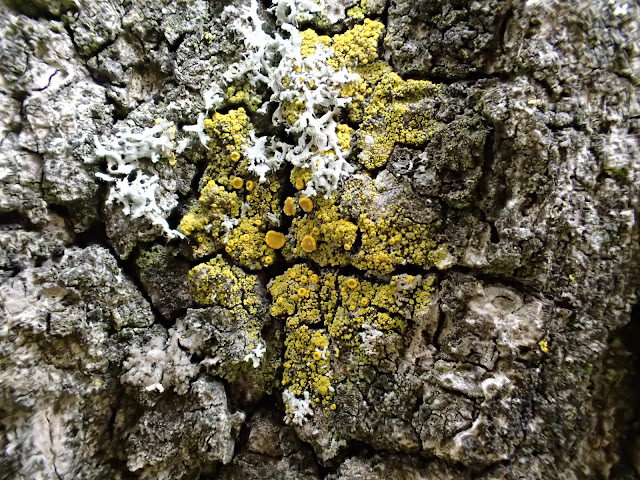Once upon a time ... (in my limited understanding) ..
lichens with yellow tiny granules or yellow soredia (powder) growing on tree trunks (other than stray Caloplacas) were Candelariella reflexa.
Species of Caloplaca turn crimson when KOH is added, and anyway they usually grow on stone. Candelariellas do not turn crimson. (Occasionally the disc in C vitellina which grows mostly on acid rock or lignin does go a bit reddish)
Recently I have been finding more and more more C reflexa on tree trunks and big branches in the valleys around Settle. (See pictures lower down). There is what looks like brown gunge on the tree trunks - lots of it - but with careful inspection with a handlens a lot of this produces yellow soredia in places, so must be a lichen. Though I cannot see squamules, as in the drawing in Dobson page 129.
Fine.
Move on to Sunday 21 Jan 2024.
I attend the BLS Field meeting at Newfield Abbey. We park in the car park, pose for a group photo and then move on to the first tree.. adjacent to the car park where we spend the first hour (typical!!)
A party has been examining the trunk.
Mark Stephens shows me his copy of Dobson. Apparently, according to Neil Sanderson, the wrong picture is with C reflexa Neil says. I have made a copy of the page and how I think it should be...
 |
| The picture (1) next to C reflexa should be moved down and placed next to C xanthostigma (which has no picture). But the black and white drawing with the tiny squamules (2) can stay where it is next to C reflexa. |
.........
but in doing all this I looked up C reflexa in the BLS website
( https://britishlichensociety.org.uk/resources/species-accounts )
and pouf! It's gone. Doesn't exist - only a link to 404.
Eventually (by going to the taxon dictionary on the website) I find a new species .. C xanthostigmoides .. apparently this is what the stuff we all (mostly) used to call C reflexa has to be called now.
Hey Ho. I will email Neil and see If I have understood things correctly
 |
| The "Experts" examining the trunk whilst I was at the other end of the branch.. |
 |
| It is a very fine tree with ever so long boughs, and splendid lichens on the fence round the tree.. If only they would give tree roots that much space in cities!! and put up a nice low fence with the square wooden slat placed like a diamond. |
I looked up these pictures of the three species concerned on the internet.
C reflexa 8 spores per ascus but apothecia rare
https://fungi.myspecies.info/all-fungi/candelariella-reflexa
https://fungi.myspecies.info/sites/fungi.myspecies.info/files/Candel-reflSP2.jpg
best:
https://italic.units.it/flora/images/species/images/TSB004127.jpg
So the above are what real C reflexa should look like.
-----------------------------------------------------------
C xanthostigma 12-32 spores per ascus, but apothecia rare.
https://italic.units.it/flora/index.php?procedure=ext_taxon_page_1&id=1668
https://lichenportal.org/portal/taxa/index.php?taxon=53285
-----------------------------------------------------------
C xanthostigmoides 8 spores in ascus
italic.units.it does not have a xanthostigmoides
https://lichenportal.org/portal/taxa/index.php?taxon=127080&clid=1287
https://www.researchgate.net/publication/266504447_Five_species_of_Candelaria_and_Candelariella_Ascomycota_Candelariales_new_to_Switzerland mentions it as coming from Australia an does not give a picture.
-------------------------------------------------------------------
Here are my pictures from different parts of this blog (which I labelled as C reflexa)
(And do email me if you think I have got them wrong or if you have bright ideas, or think I should have labelled any of them them C vitellina)
1. Cherry tree at entrance to Ingleton Churchyard 2014, fourth picture down
 |
| On "Melanohalea tree" at Giggleswick |
 |
| Hyperphyscia adglutinata on hornbeam in Settle Play area at Primary School, - but see tiny yellow flecks of C "reflexa" top right. |
 |
| Lone ash tree on rocks far above Giggleswick School .. well this has apothecia so maybe I should go back and sample them |
 |
| See dots on the right. |
 |
| On wooden seat at St Chad's Leeds so wondering if it is C vitellina |
 |
| with Parmelina pastillifera and many other species on alder trunk in Ribble floodplain |




No comments:
Post a Comment